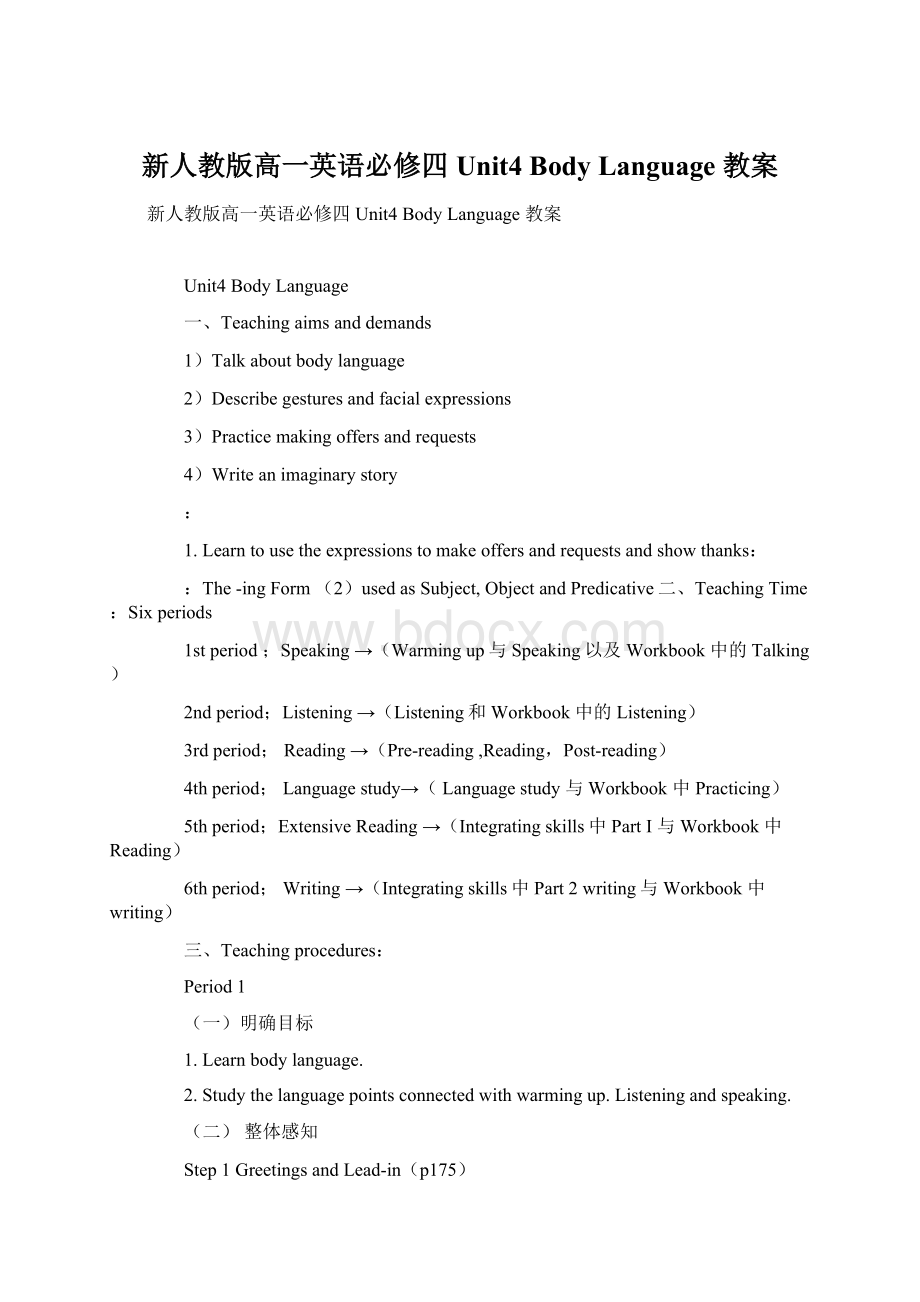新人教版高一英语必修四 Unit4Body Language教案.docx
《新人教版高一英语必修四 Unit4Body Language教案.docx》由会员分享,可在线阅读,更多相关《新人教版高一英语必修四 Unit4Body Language教案.docx(22页珍藏版)》请在冰豆网上搜索。

新人教版高一英语必修四Unit4BodyLanguage教案
新人教版高一英语必修四Unit4BodyLanguage教案
Unit4BodyLanguage
一、Teachingaimsanddemands
1)Talkaboutbodylanguage
2)Describegesturesandfacialexpressions
3)Practicemakingoffersandrequests
4)Writeanimaginarystory
:
1.Learntousetheexpressionstomakeoffersandrequestsandshowthanks:
:
The-ingForm
(2)usedasSubject,ObjectandPredicative二、TeachingTime:
Sixperiods
1stperiod;Speaking→(Warmingup与Speaking以及Workbook中的Talking)
2ndperiod;Listening→(Listening和Workbook中的Listening)
3rdperiod;Reading→(Pre-reading,Reading,Post-reading)
4thperiod;Languagestudy→(Languagestudy与Workbook中Practicing)
5thperiod;ExtensiveReading→(Integratingskills中PartI与Workbook中Reading)
6thperiod;Writing→(Integratingskills中Part2writing与Workbook中writing)
三、Teachingprocedures:
Period1
(一)明确目标
1.Learnbodylanguage.
2.Studythelanguagepointsconnectedwithwarmingup.Listeningandspeaking.
(二)整体感知
Step1GreetingsandLead-in(p175)
Step2Presentation.
Peoplecommunicatewitheachotherinmanyways:
bodylanguage,writing,speaking,typing.Makeadialogueinpairsusingbodylanguage.
(三)教学过程
Step3Warming-up(p176)
Gothroughwarmingupandmakesurethestudentsunderstanditandcanmatcheachpicturewiththecorrectemotionandthecorrectsentence.
(1)Actionshow:
Trytouseyourbodytoactoutthenextactions
Stop!
Comehere.Youareverygood.It’sok.Bye-bye.
(Whatisbodylanguage?
Bodylanguageisthemovementsorpositionsofourbody.Weusethemtoshowotherpeoplewhatwearethinkingaboutandhowwearefeeling.)
(2)Matcheachpicturewiththecorrectemotionandthecorrectsentence.
Possibleanswers:
Picture1:
Confused;Idon’tknowwhattodo.
Picture2:
Angry;Ican’tbelieveshesaidthat!
Thatissounfair!
Picture3:
Sad;I’velostmywallet!
Picture4:
Happy;IgotanAinmyexam!
Picture5:
Tired;It’sbeenalongday.Ican’tkeepmyeyesopen.
(3)Talkaboutthepictures
1)HowdoesthemaninPicture1feel?
Hefeelsveryconfusedbecausehedoesn’tknowwhattodo.
2)HowdoesthemaninPicture2feel?
HefeelsveryangrybecausehethinksitwasunfairforMarytosaythattohim.
3)HowdoesthemaninPicture3feel?
(Hefeelsverysadbecausehehaslosthiswallet.)
4)HowdoesthemaninPicture4feel?
(HefeelsveryhappybecausehehasgotanAinmaths.)
5)HowdoesthemaninPicture5feel?
Hefeelsverytiredandhenearlycannotkeephiseyesopen.
(4)Answerthequestions
Step4Speaking
(1)Chooseoneofthesituationtoactoutusingtheusefulexpressionsintheblanks:
Situation1:
Anoldmaniscarryingaveryheavysuitcase
Situation2:
Somebodyislateforaflightandwantstogoaheadofthequeue.
Situation3:
Anoldandsickpersonisonacrowdedbusandwantstositdown.
(2)Phrasestoacceptoffers/refuseoffers:
1)That’sveryniceofyou.Thanks./Yes,please.
Thankyouforyourhelp.That’sverykind.
2)No,thanks.Icanmanageitmyself.It’sallright.Thankyou.Icanmanage.
(3)Sample:
Situation1
Askingforhelp
O=oldmanP=Paul
O:
Excuseme,youngman.Couldyougivemeahandwiththis,please?
It’sveryheavy.
P:
Oh,ofcourse,I’dbehappyto.Therewego.
O:
Thankyou.
P:
You’rewelcome.
O:
Ohmy,thisisheavy.Excuseme,sir,couldyouhelpmewiththisbag?
P:
Certainly.WhereshouldIputit?
O:
Thankyou.Justputitoverthere,please.
P:
Thereyouare.
O:
Thankyou,that’sveryniceofyou.
Offeringhelp
P:
Thatbaglooksveryheavy.Doyouneedsomehelpwiththat?
O:
Oh,thankyou.Couldyoupleaseputitoverthere?
P:
Noproblem.Thereyouare.IsthereanythingelseIcandoforyou?
O:
No,thankyou.Thanksyouforallyourhelp.
P:
Wouldyoulikesomehelp?
O:
Oh,yes,please.Thisbagissimplytooheavyforme.Couldyougivemeahandwithit?
P:
Sure.My,thisbagisheavy!
Ah,therewego.WhereshallIputit?
O:
Overthere,please.Thankyousomuch!
P:
You’rewelcome.
Situation2
J=JimA=PassengerAB=PassengerB
J:
Excuseme,butI’mlateformyflight.CouldIpleasegoaheadofyou
A:
Whysure.Myflightdoesn’tleaveforanotherhour.Arethesebagsyours?
ShallIhelpyouwiththat?
J:
No,thanks.Icanmanageitmyself.(Tothepassengerstandingatthecheck-incounter.)Icutinfrontofyou?
Idon’twanttomissmyplane.
B:
Gorightahead.I’mstilllookingformyticket.Doyouneedsomehelpwiththatbag?
J:
Yes.Couldyoupleasehelpmeputituphere?
Thankyou.
B:
You’rewelcome.
J:
Ohno!
I’mlateformyflight.
A:
Excuseme,butdidyousaythatyouwerelate?
Wouldyouliketogoaheadofme?
Myflightdoesn’tleaveforanotherhour.
J:
Thankyou,that’sveryniceofyou!
Couldyouhelpmewiththisbag,please?
A:
Sure.Thereyouare.Wouldyoulikemetobringituptothecounter?
J:
Oh,no,thankyou.Icanmanageitmyselfnow.
Situation3
(O=Oldperson;P=Passenger)
O:
Ohmy,thisbusiscrowded.Excuseme,couldyoupleasehelpmewiththisbag?
P:
Certainly.Thereyouare.Here,pleasetakemyseat,youlookabittired.
O:
Thankyou.Yes,I’mnotfeelingwelltoday.IthinkIhaveabitofcold.CouldyoupleasetellmewhenwereachLongStreet?
I’mafraidIcan’tseewherewearewhenthebusisthiscrowded.
P:
Sure.I’llletyouknowwhenwegetthere.
P:
ShallIhelpyouwiththat?
O:
Nothanks.Icanmanageitmyself.Butcouldpleaseletmesitdownforawhile?
I’mnotfeelingwell.
P:
Oh,ofcourse.Pleasetakemyseat.
O:
Thankyou.That’sveryniceofyou.
P:
Notatall.
Step5Languagepoints
1.keepmyeyesopen使眼睛睁开着
★keep跟带形容词的复合结构,例如:
①Goodfoodkeepsyouhealthy.好的食品使你健康。
②Pleasekeeptheboyquiet.请让这男孩安静。
★另外keep还可以跟带分词、介词短语、副词的复合结构。
①Shekeptwewaitingoutside.她让我在外面等着。
②Hekepthiseyesshutandstayedwherehewas.他闭着眼睛待在原地。
③ifyourhandsarecold,keeptheminyourpockets.如果你手冷,把它们放在口袋里。
④Thecoldweatherkeptindoors.寒冷的天气使我们待在家里。
2.besureof/todo.
①Heissureofsuccess=heissurethathewillsucceed.
②Heissuretosucceed=hewillcertainlysucceed.
③I’msureofthefact.我确实相信这件事。
④.Besurenottoforget.千万别忘记了。
3.Canyoutellhowtheyarefeelingtodaybythewaytheysitorstand?
(Warmingup)
★tell在句中作“说出,判断,看出”解,常与情态动词can/could连用或用于不定式结构中。
如:
ItwassodarkthatIcouldn’ttellthatitwasyou.天太黑了,我认不出那就是你。
It’sdifficulttotellwhenitwillbefinished.很难说得准何时完成这项工作。
★另外,与之相关的短语有:
tellapart意为“把……区分开”;tellfrom(by)意为“从(以)……可以看出”;tell...from...意为“把……与……区分开来,分清……,区别……”。
Ireallycan’ttellwhichiswhichbytheirappearances.
我从外表实在看不出哪个是哪个。
Ican’ttellJanefromSarah(=tellJaneandSarahapart)—theylooksoalike.
我分辨不出简和萨拉,她们长得太像了。
4.Thecustomersaid“Idon’twanttotalk”byavoidingeyecontact.(Listening)
★avoid意为“避开,避免”,为及物动词,后可接名词、代词及动词-ing形式。
如:
Iavoidedhimasmuchaspossible.我尽量避开他。
Theyallavoidedmentioningthatname.他们都避免提及那个名字。
Shebrakedsuddenlyandavoidedanaccident.她紧急刹车,避免了一场事故。
5.interestedadj.感兴趣的
(1)Helookedinterested.他看起来很感兴趣.
(2)HeisveryinterestedinthestudyofEnglish.他对学英语很感兴趣。
(3)Heisinterestedtoknowherpersonalhistory.
他对她的经历感兴趣(想知道她的经历)。
★interesting也是形容词,表示“某人或事令人感兴趣,能引起兴趣,有趣的”.
(1)aninterestinggame/boy有趣的比赛/男孩
(2)Thisplanisinterestingtous.这个计划令我们感到有趣o
(3)Ihavesomethinginterestingtotellyou.我有一件有趣的事要告诉你.
(4)Itisinterestingtowatchbirds.赏鸟非常有趣.
6.leanvi.倾斜;屈身;依靠、倚靠
(1)Thetowerisleaningslightly.那座塔轻微倾斜。
(2)Heleanedforward(down)tohearwhatshesaid.
他俯身向前弯下身子)想听她说什么。
(3)Heleanedagainstthetree.他倚靠着那棵树。
7.communicatev.传达、表达(信息);取得联系
(1)Hecommunicatedhisintentiontome.他把他的意向告诉了我。
(2)Wecommunicatewitheachotherbyletter.我们用书信彼此联络.
★communicate的名词形式为communication.
Languageisamajormeansofcommunication.语言是主要的交际工具。
8.inahurry匆忙,仓促
(1)Helefttheminahurry.他匆忙离开他们.
(2)Don’tbeinahurry.Thereisplentyoftime.
=Don’thurry.Thereisplentyoftime.别忙,时间还多着呢。
9.disagreewith=notagree
①Evenfriendssometimesdisagree.既使是朋友,有时意见也不相同。
②ThereportsfromRomedisagreewiththosefromMilan.
来自罗马的报导与来自米兰的报导不一致。
③Theclimatedisagreeswithme.我不适应这气候。
★agreev.同意,答应
agreetodosth.同意(赞成)干某事agreethat...同意…agreetosth同意某事
agreewithsb/sth.赞成某人/某事agreeonsth.对…取得一致意见
(1)Iaskedhimtohelpmeandheagreed.我要他帮我的忙,他同意了。
(2)Theyagreedthatitwasamistake.他们同意这是一个错误。
(3)Hedidn’tagreetotheplan.他不赞成那个计划。
(4)Theydon’tagreewithoneanother.他们之间互不同意。
★辨析:
agreewith,agreeto,agreeon
(1)agreewith的意思是“同意…”,“赞成…”,后面接指人或表示“意见”“看法”的词。
Wequiteagreewithwhatyousaid.我们同意你说的话。
(2)agreewith还有“与……一致”,“(气候、食物等)适合”的意思。
Theverbmustagreewiththesubjectinpersonandnumber.
动词在人称和数上应与主语一致。
Theclimateheredoesn’tagreewithhim.他不适应这里的气候。
(3)agreeto的意思是“同意……”“赞成……”,后面接表示“提议”“办法”“计划”等的词。
Doyouagreetothisarrangement?
你赞成这个安排吗?
(4)agreeon的意思是“对……取得一致意见”。
主语常常是协商一件事的人们或单位,后面常接表示具体协议的文件、计划、行动等名词。
Afterdiscussion,thetwosidesagreedonacease-fire.经过讨论,双方达成了停火协定。
10.managevt.&vi.设法做好;想法达到(常与can,could连用);经营;管理
(1)ThiskindofTVsetisdifficulttorepairbutIcanmanage.
这种电视机很难修理,但我能设法修好。
(2)Theboxwasheavybuthemanagedtocarryit.那箱子很重,但他仍设法搬动它。
(3)Heismanagingthebusinessforhisfather.他代他父亲做生意。
(4)Thestorewasbadlymanaged.这家商店的经营不善。
★比较:
managetodosth./trytodosth./trydoingsth.
(1)managetodosth.意为“设法完成”,表示经过努力达到了